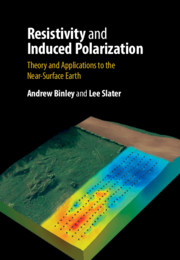Book contents
- Resistivity and Induced Polarization
- Reviews
- Resistivity and Induced Polarization
- Copyright page
- Contents
- Preface
- Acknowledgements
- Symbols
- 1 Introduction
- 2 Electrical Properties of the Near-Surface Earth
- 3 Instrumentation and Laboratory Measurements
- 4 Field-Scale Data Acquisition
- 5 Forward and Inverse Modelling
- 6 Case Studies
- 7 Future Developments
- Appendix A Modelling Tools
- References
- Index
- Plate Section (PDF Only)
2 - Electrical Properties of the Near-Surface Earth
Published online by Cambridge University Press: 17 December 2020
- Resistivity and Induced Polarization
- Reviews
- Resistivity and Induced Polarization
- Copyright page
- Contents
- Preface
- Acknowledgements
- Symbols
- 1 Introduction
- 2 Electrical Properties of the Near-Surface Earth
- 3 Instrumentation and Laboratory Measurements
- 4 Field-Scale Data Acquisition
- 5 Forward and Inverse Modelling
- 6 Case Studies
- 7 Future Developments
- Appendix A Modelling Tools
- References
- Index
- Plate Section (PDF Only)
Summary
The electrical properties of the near-surface Earth depend on the chemical properties of the fluids filling pores, grain size, the geometry of the interconnected pore network and mineralogy of the solids. We first describe how electrical resistivity depends on the ionic composition of an electrolyte. We next discuss the controls on the resistivity of a porous medium. We start with Archie’s laws and summarize the development of the parallel conduction model used to incorporate surface conduction at the solid–fluid interface. We describe how the induced polarization (IP) effect in the case of a non-electronically conducting matrix is incorporated into the parallel conduction model through a complex surface conductivity. Models to describe the frequency dependence of resistivity in terms of a distribution of polarization length-scales, e.g. grain sizes or pore sizes, are reviewed. We discuss models to describe the mechanisms causing the large polarization enhancement observed in the presence of electronically conducting minerals and show how IP parameters are, in this case, related to the volume and size of the electronically conducting particles. We finish by considering the role of contaminants in modifying electrical properties of near surface materials and briefly consider the possibility of non-linear effects in measurements.
- Type
- Chapter
- Information
- Resistivity and Induced PolarizationTheory and Applications to the Near-Surface Earth, pp. 18 - 99Publisher: Cambridge University PressPrint publication year: 2020
- 1
- Cited by



